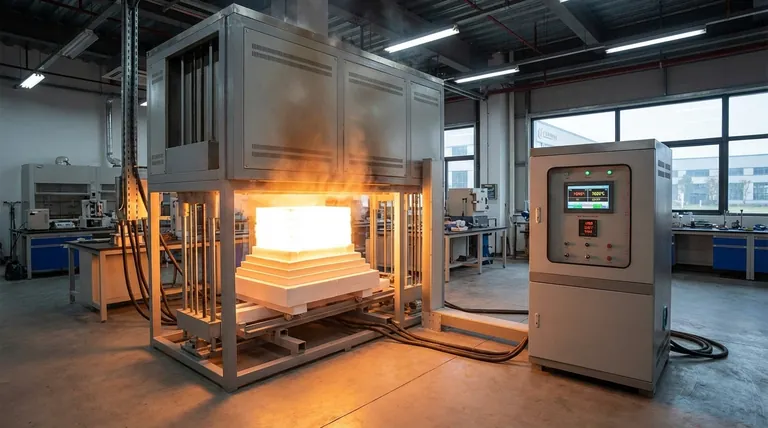The ideal temperature for a furnace depends entirely on its purpose. For a residential furnace, the recommended thermostat setting is between 68°F and 72°F to maintain comfortable indoor air temperature. In stark contrast, an industrial furnace operates at extreme internal temperatures, often ranging from 1,500°F to over 5,000°F, to physically alter materials.
The term "furnace temperature" has two vastly different meanings. For a homeowner, it refers to the thermostat setting for air comfort. For an industrial operator, it refers to the extreme heat inside the equipment required for a specific manufacturing process.

The Residential Furnace: Setting Your Thermostat
A home furnace's job is not to reach a specific internal temperature but to produce enough heat to bring your living space to the temperature you set on your thermostat. The numbers discussed here are for the thermostat, not the flame inside the unit.
The Standard Recommendation
The U.S. Department of Energy recommends a baseline temperature range of 68°F to 72°F during the day when you are home. This range provides a balance between comfort and energy efficiency.
Adjusting for Occupant Needs
Comfort is subjective and depends on the health and age of those in the home. For households with elderly persons, a higher temperature, sometimes up to 78°F, is often recommended to ensure their comfort and well-being.
The Industrial Furnace: A World of Extreme Heat
Industrial furnaces are not used for comfort but for manufacturing and material science. Their purpose is to apply precise, intense heat to transform materials through processes like sintering, annealing, or melting.
Typical Operating Ranges
The internal operating temperatures of industrial furnaces are immense. Most vacuum furnace systems, for example, have a maximum operating temperature range between 1,500°F and 5,400°F.
The Concept of Process Temperature
In an industrial context, the process temperature is the maximum temperature at which the furnace can operate and still maintain its rated performance and safety standards. This is a critical specification determined by the manufacturer.
Temperature Varies by Process
The required temperature is dictated entirely by the material and the goal. Sintering furnaces, for example, must heat materials to a point just below their melting point to fuse particles together without liquefying them.
A typical heat treatment program might involve multiple stages, such as raising the temperature to 800°C (1472°F) for a set time, then slowly warming it to 1100°C (2012°F) to complete the process.
Understanding the Critical Difference
Confusing these two types of furnaces is more than a simple misunderstanding; their goals are fundamentally opposed. One seeks to create a stable, comfortable environment, while the other creates a volatile, transformative one.
Goal: Regulating Air vs. Transforming Materials
A residential furnace uses a thermostat as a sensor to regulate ambient air temperature. It cycles on and off to maintain a set point. An industrial furnace uses thermocouples and controllers to precisely manage extreme internal heat according to a strict, pre-programmed schedule.
The Impact of Scale and Purpose
The difference in purpose dictates every aspect of design, from the energy source and materials used to the safety controls. The principles governing a home HVAC system are entirely different from those governing a high-temperature vacuum furnace.
Making the Right Choice for Your Goal
The correct temperature setting is a direct function of your specific objective.
- If your primary focus is home comfort and energy savings: Set your thermostat to the DOE-recommended 68°F and adjust slightly for personal comfort.
- If your primary focus is an industrial process: The required temperature is dictated by the material's data sheet and the specific process (e.g., sintering, brazing) you are performing.
Ultimately, understanding the context of your furnace—whether for living space or for material science—is the key to setting the correct temperature.
Summary Table:
| Furnace Type | Purpose | Typical Temperature Range | Key Control Mechanism |
|---|---|---|---|
| Residential Furnace | Home Comfort & Energy Efficiency | 68°F - 72°F (up to 78°F for elderly) | Thermostat (Ambient Air Sensor) |
| Industrial Furnace | Material Transformation (Sintering, Annealing) | 1,500°F - 5,400°F+ | Thermocouples & Programmable Controllers (Process Temperature) |
Need precise, high-temperature control for your lab or production process? KINTEK specializes in industrial lab furnaces and equipment designed for demanding applications like sintering, annealing, and heat treatment. Our experts can help you select the right furnace with the exact temperature range and controls your process requires. Contact our team today to discuss your specific needs and achieve superior results.
Visual Guide

Related Products
- Laboratory Muffle Oven Furnace Bottom Lifting Muffle Furnace
- 1800℃ Muffle Oven Furnace for Laboratory
- 1400℃ Muffle Oven Furnace for Laboratory
- 1700℃ Muffle Oven Furnace for Laboratory
- 1400℃ Laboratory Quartz Tube Furnace with Alumina Tube Tubular Furnace
People Also Ask
- What is the temperature limit on a muffle furnace? A Guide to Selecting the Right Model
- What is the difference between a crucible and a furnace? Understanding the Heat Source and Container Partnership
- Does melting point ever change? Unlock the Secrets of Pressure and Purity
- Do different liquids melt at different rates? Unlock the Science of Melting Points and Material Properties
- What are the factors affecting the rate of melting process? Master Heat Transfer for Faster Results



















